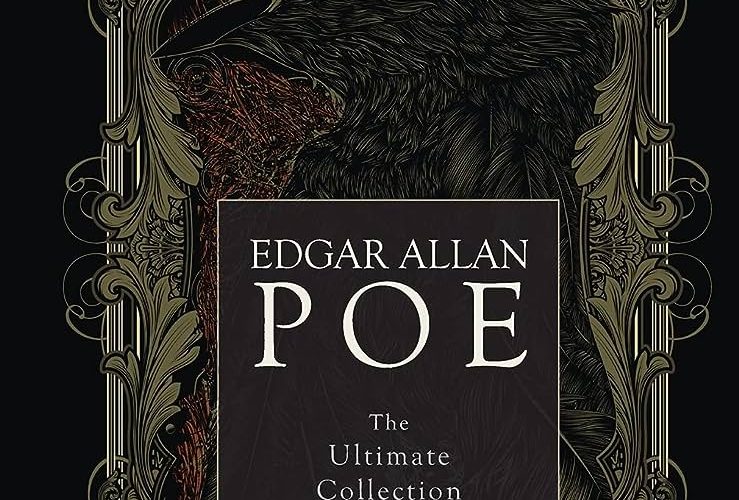The Master of the Macabre: Edgar Allan Poe’s Life and Legacy

As an Amazon Associate I earn from qualifying purchases.
Edgar Allan Poe was one of the most influential and original writers of American literature. He is best known for his tales of mystery and horror, as well as his poems that explore the dark and romantic aspects of human nature. In this blog post, we will look at some facts about his life and work that you may not know.
Early Life and Education
Poe was born on January 19, 1809, in Boston, Massachusetts, to David and Elizabeth Poe, both actors. His father abandoned the family when Poe was a baby, and his mother died of tuberculosis when he was two years old.
He was taken in by John and Frances Allan, a wealthy couple from Richmond, Virginia, who gave him their surname as his middle name. He grew up in a comfortable and cultured environment, but had a strained relationship with his foster father, who disapproved of his literary ambitions.
He attended the University of Virginia for one year, but had to drop out due to gambling debts and lack of funds from his foster father. He then enlisted in the army under the name Edgar A. Perry, and served for two years. He also published his first book of poems, Tamerlane and Other Poems, anonymously in 1827.
He attended the United States Military Academy at West Point for a few months in 1830, but was dismissed for disobeying orders. He then moved to Baltimore, where he lived with his aunt Maria Clemm and her daughter Virginia, who would later become his wife.
Literary Career and Achievements
Poe worked as an editor, critic, and writer for various magazines and newspapers in Baltimore, Philadelphia, and New York. He earned a reputation for his harsh and witty reviews, as well as his original and innovative stories and poems.
He is widely regarded as the inventor of the detective fiction genre, with his stories featuring the brilliant and eccentric sleuth C. Auguste Dupin, such as “The Murders in the Rue Morgue” (1841), “The Mystery of Marie Roget” (1842), and “The Purloined Letter” (1844).
He also pioneered the genre of science fiction, with his stories that explored the mysteries of the universe, such as “MS. Found in a Bottle” (1833), “A Descent into the Maelstrom” (1841), “The Facts in the Case of M. Valdemar” (1845), and “Eureka” (1848).
He is most famous for his tales of horror and suspense, which create a mood of terror and psychological intensity through his masterful use of language, imagery, symbolism, and irony. Some of his most celebrated stories include “The Fall of the House of Usher” (1839), “The Pit and the Pendulum” (1842), “The Tell-Tale Heart” (1843), “The Black Cat” (1843), “The Cask of Amontillado” (1846), and “The Masque of the Red Death” (1842).
He is also renowned for his poetry, which expresses his complex emotions and themes of love, death, beauty, madness, and despair. Some of his most popular poems include “To Helen” (1831), “The Raven” (1845), “Annabel Lee” (1849), “Ulalume” (1847), “The Bells” (1849), and “Lenore” (1843).

Personal Life and Death
Poe married his cousin Virginia Clemm in 1836, when she was 13 years old and he was 27. They had a close and devoted relationship, but Virginia suffered from tuberculosis and died in 1847, leaving Poe heartbroken and depressed.
Poe struggled with alcoholism and poverty throughout his life. He also had several romantic affairs and engagements after Virginia’s death, but none of them lasted or ended happily.
He died on October 7, 1849, in Baltimore, under mysterious circumstances. He was found delirious and incoherent on the streets, wearing someone else’s clothes. He was taken to a hospital, where he uttered his last words: “Lord help my poor soul.” The cause of his death remains unknown, but some possible explanations include alcohol poisoning, rabies, brain disease, murder, or suicide.
He was buried in an unmarked grave in Baltimore’s Westminster Burying Ground. In 1875, a monument was erected over his grave by public donations. His original tombstone was destroyed by a train accident before it could be installed.
Legacy and Influence
Poe is widely recognized as one of the most original and influential writers of American literature. His works have inspired countless authors, artists, musicians, filmmakers, and scholars, both in America and around the world.
He is considered a major figure of the American Romantic movement, as well as the Gothic and Dark Romantic subgenres. He influenced writers such as Nathaniel Hawthorne, Herman Melville, Charles Baudelaire, Fyodor Dostoyevsky, Arthur Conan Doyle, H.P. Lovecraft, and Stephen King.
He is also regarded as a precursor of modernism and postmodernism, as well as the genres of horror, science fiction, fantasy, and mystery. He influenced writers such as Jules Verne, H.G. Wells, Jorge Luis Borges, Franz Kafka, Ray Bradbury, and Edgar Rice Burroughs.
He is honored by various awards, societies, museums, and landmarks that bear his name or are dedicated to his memory. He is also featured in numerous books, films, plays, musicals, comics, and games that depict or adapt his life and works.
Conclusion
Edgar Allan Poe was a remarkable writer who left behind a rich and diverse legacy of literary works that continue to fascinate and inspire readers and creators of all ages and backgrounds. He was a visionary who explored the depths of the human mind and the mysteries of the universe with his imagination and skill. He was a genius who shaped the course of American literature and culture with his originality and influence.
Amazon and the Amazon logo are trademarks of Amazon.com, Inc, or its affiliates.










